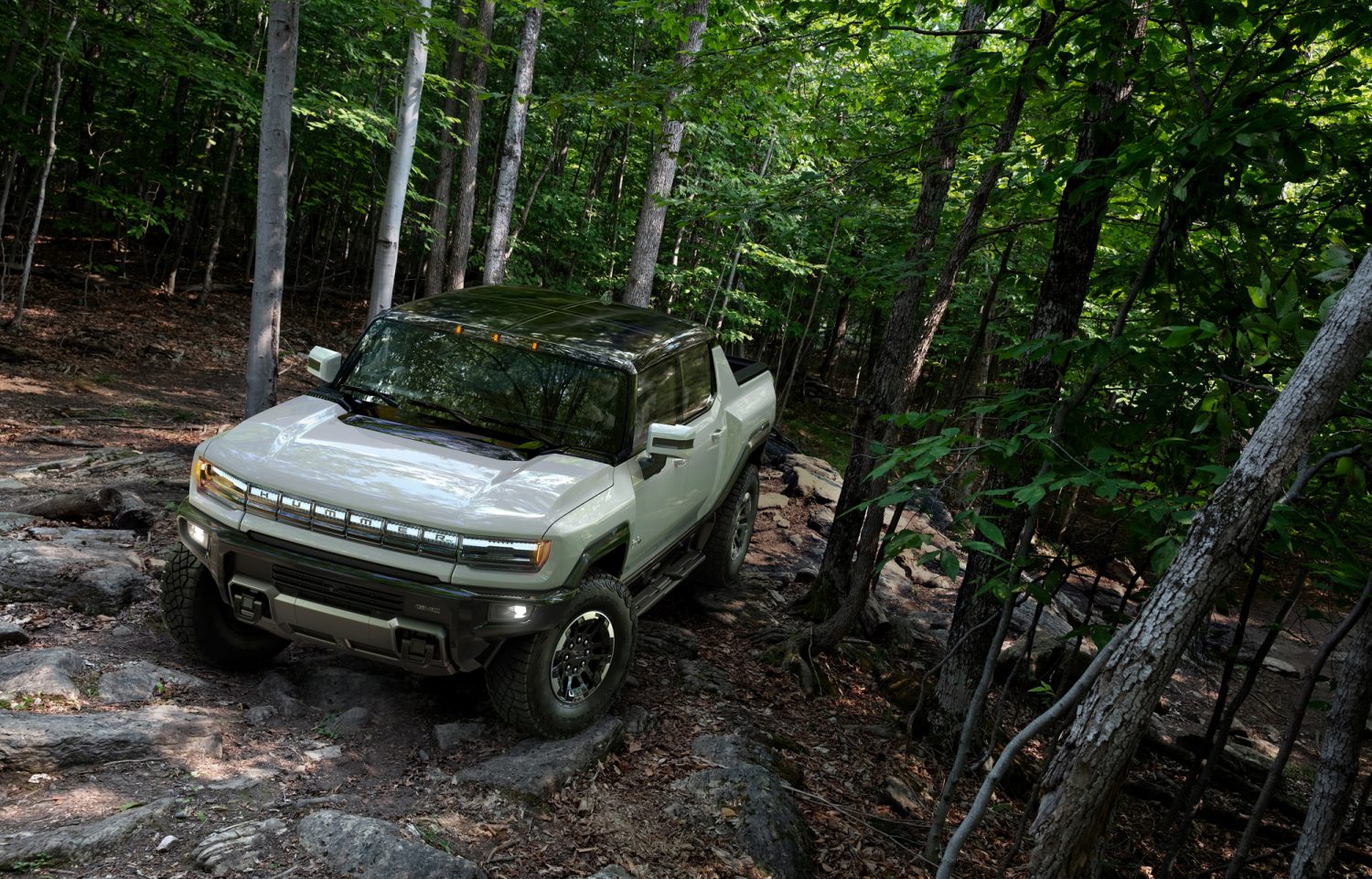Bearing down on the steering wheel and settling into the seat of the Edition One Hummer EV, I prepared for the sensation of rapid acceleration that was about to be unleashed. My left foot was firmly planted on the vehicle’s brake pedal while my right foot simultaneously pressed the accelerator to the floor. A humming noise was being piped into the cockpit from the vehicle’s Bose speakers. That sound, combined with the message on the driver’s instrument cluster, indicated that Watts to Freedom was ready to unleash the Hummer EV’s 1,000 horsepower and 1,200 pound-feet of torque.
Rubber screamed to life against the pavement as the rocket ship took off. Seeing the end of the course quickly approaching, I resisted the urge to step on the vehicle’s brakes before crossing the finish line. The three-second zero to sixty launch was brutally fast, but the real shocker for me was the similarly quick deceleration given the Hummer’s 10,000-pound GVW.
The Hummer EV is full of surprises like this.
Hummer EV Interior, Controls, Supercruise, and lots of Cameras
The interior of the Hummer EV feels like the best place to begin our evaluation as it is where all of the technology and features of this supertruck intersect.
Hummer EV Interior
Yes, it’s a rocket ship, and the inside feels like one, too. From the combined 25+ inches of digital displays, to the multi-textured surfaces, the interior design of the Hummer EV is at once futuristic while also feeling retro-familiar. Specifically, the gold-toned air vents reminded me of the coveted gold Nintendo-64 controller from my gaming days. Proud Millenial right here.



Seating and Controls
The Hummer’s seating was comfortable for our full day of driving on pavement and dirt and offered enough adjustability to accommodate both large and small drivers, alike.
Seated in the cockpit, I appreciated the two rows of piano-key switches that were centrally located below the infotainment screen. The upper, smaller set, is not permanently labeled, and their functions change based on the particular screen that you are viewing; it’s a clever way of connecting functions on the screen with physical switches. The lower row of keys is larger, and has permanent functions, like toggling locking differentials, traction control, hazard lights, parking assist sensors, and more. While the overall experience of using the controls was pleasant, engaging the locking differentials felt a bit clunky. This editor will assume that software updates may address this in the future.
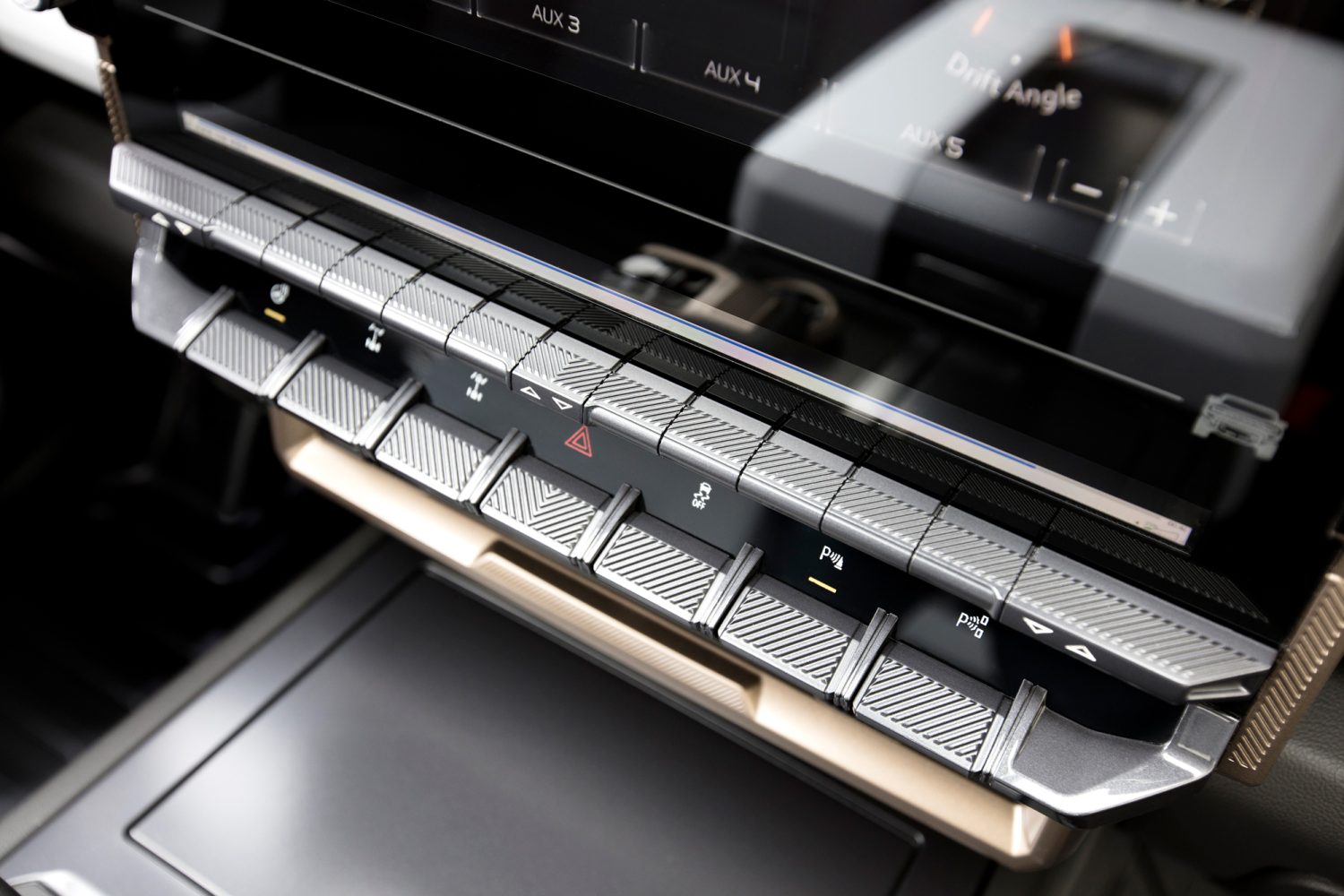
The center console-located shift lever was straightforward to operate, and the driving mode dial is positioned directly behind it. This dial allows the driver to change between the Hummer’s five driving modes, which include off-road and terrain modes among others. These two off-highway modes provide significantly different performance characteristics that optimize for either high- or low-speed performance.
The terrain mode must be selected to enable one-pedal driving as well as the option to utilize the vehicle’s locking differentials. Purists may find this frustrating.

The steering wheel has a variety of buttons for performing vehicle functions without needing to remove your hands. My favorite was the on-demand regenerative braking paddle that is operated with the left hand. This allows the user to manually recover kinetic energy, bolstering vehicle range. I found it enjoyable to use and often utilized it before resorting to the standard brake pedal when I needed to slow the truck.
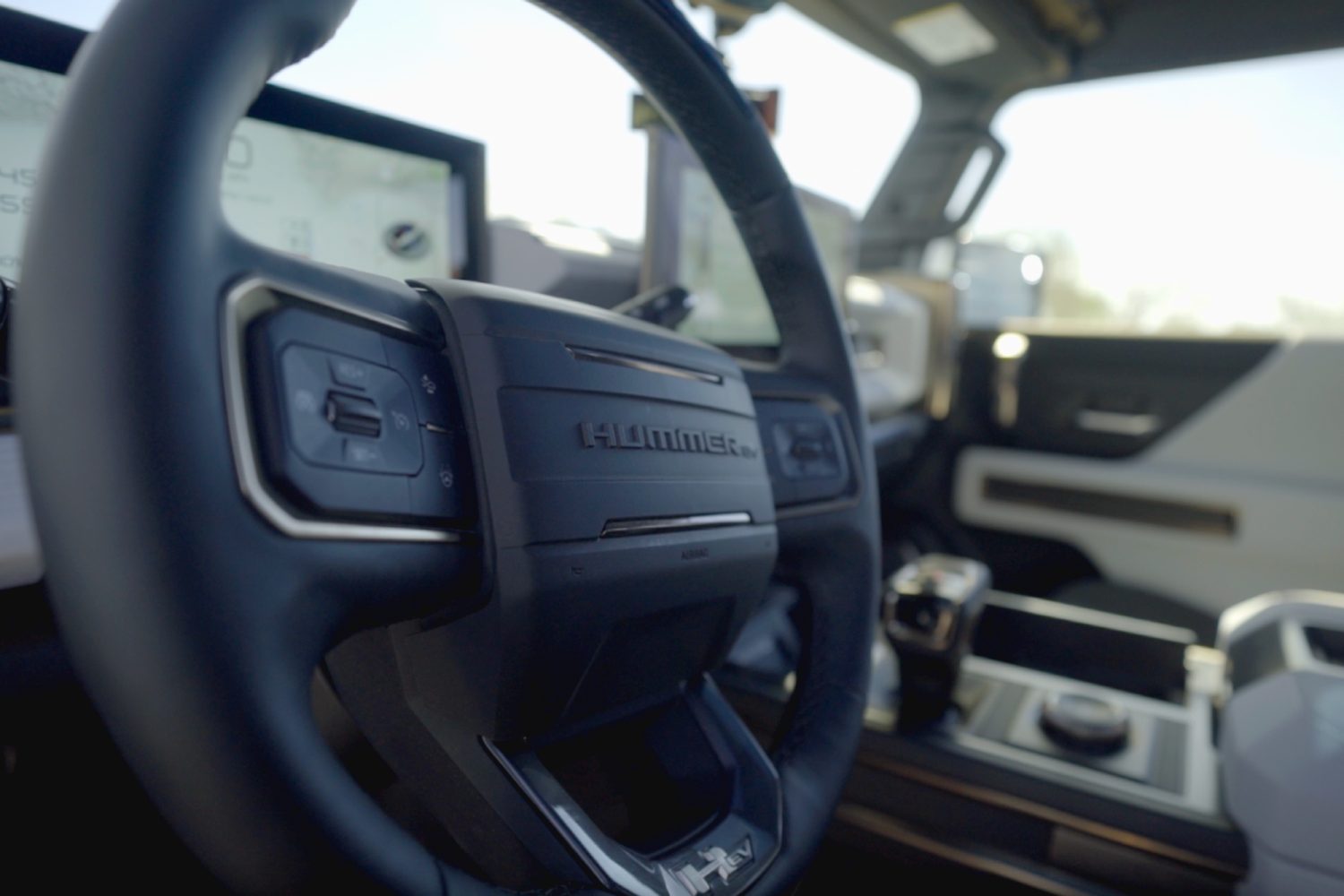
Supercruise
Of special interest was the Hummer EV’s Super Cruise feature; it’s a self-driving mode that allows the user to sit back and relax while the truck does the work.
Engaging Super Cruise was as simple as pushing a single button on the steering wheel. A prompt on the driving display as well as a green light on the steering wheel confirmed that I could remove my hands. The truck immediately took over and did a surprisingly good job of holding the lane without any wandering or swerving. It also surprised me when it signaled, accelerated, and passed a car that was in front of me.
On a few occasions, the Hummer exited self-driving mode around exit lanes and exchanges. This was a great reminder that in any self-driving car the driver should be prepared to resume driving responsibilities, for the safety of everyone in your vehicle. Potential owners should note that there are approximately 200,000 miles of approved Super Cruise-compatible roads, and these are the only routes where the feature currently works.
The Hummer EV has 18 Cameras. Really.
If one backup camera feels convenient, imagine what having 18 cameras providing a complete 360-degree view of your vehicle, including the undercarriage, is like. That’s right. It’s awesome.
While I’m sure you could get by with a few less than 18, the result of having a complete view of your vehicle inspires loads of confidence on the trail and in tight urban environments. Utilizing the camera system allowed me to remain in a comfortable, relaxed position in my seat, and in turn, resulted in less driver fatigue after spending many hours behind the wheel.
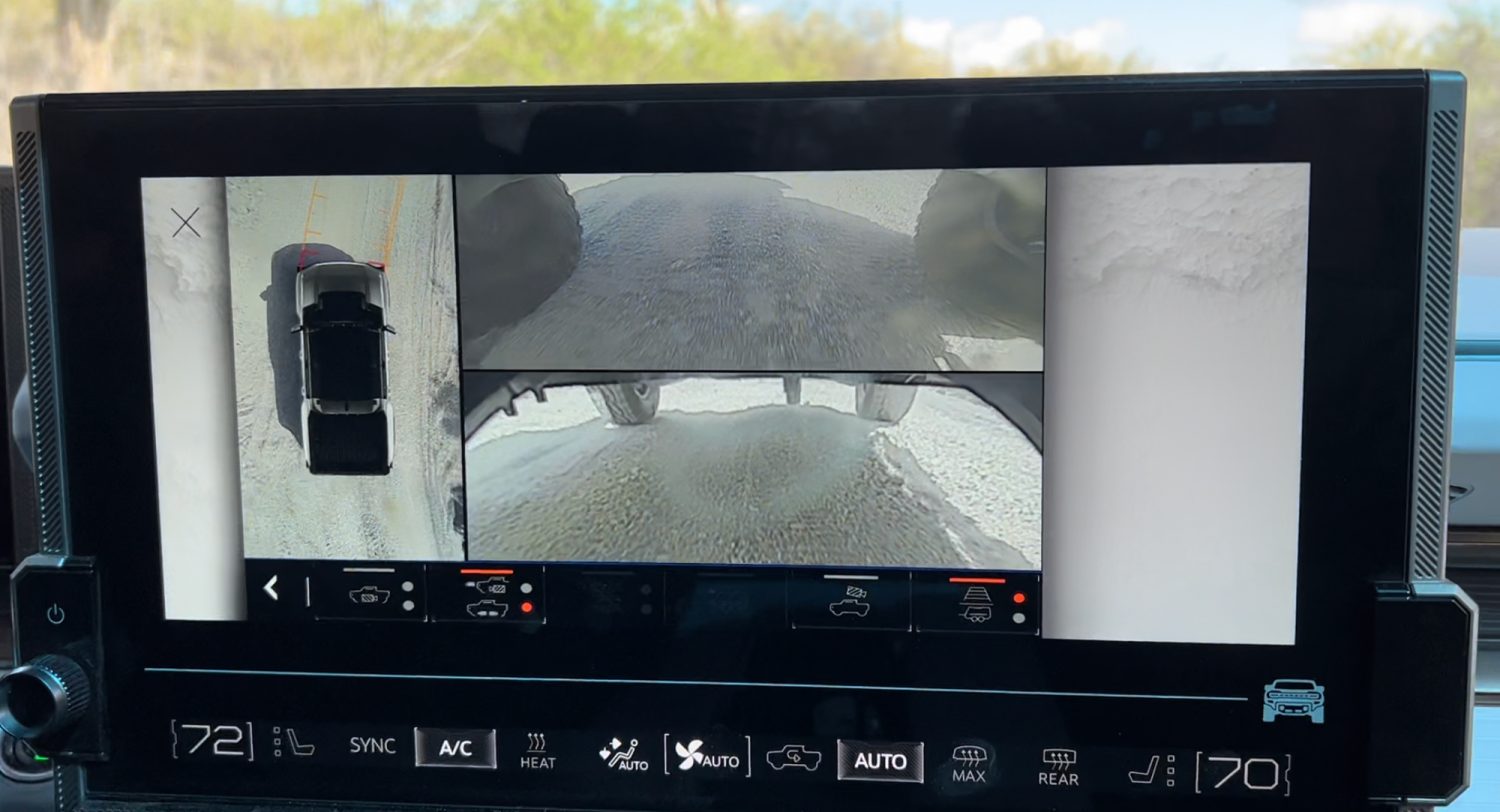
You can switch between many different camera view combinations on the infotainment screen depending on what views are most valuable to you. Some of the cameras even have little spray nozzles that will wash off their lenses if visibility is impeded by dirt and grime.
Glass All-around
The hummer’s infinite roof (glass ceiling) is made up of four rigid panels that can be removed and stored in the truck’s frunk. With the roof removed and the rear window rolled down, the experience of unrestricted airflow through the cabin is quite pleasant, especially on the trail.

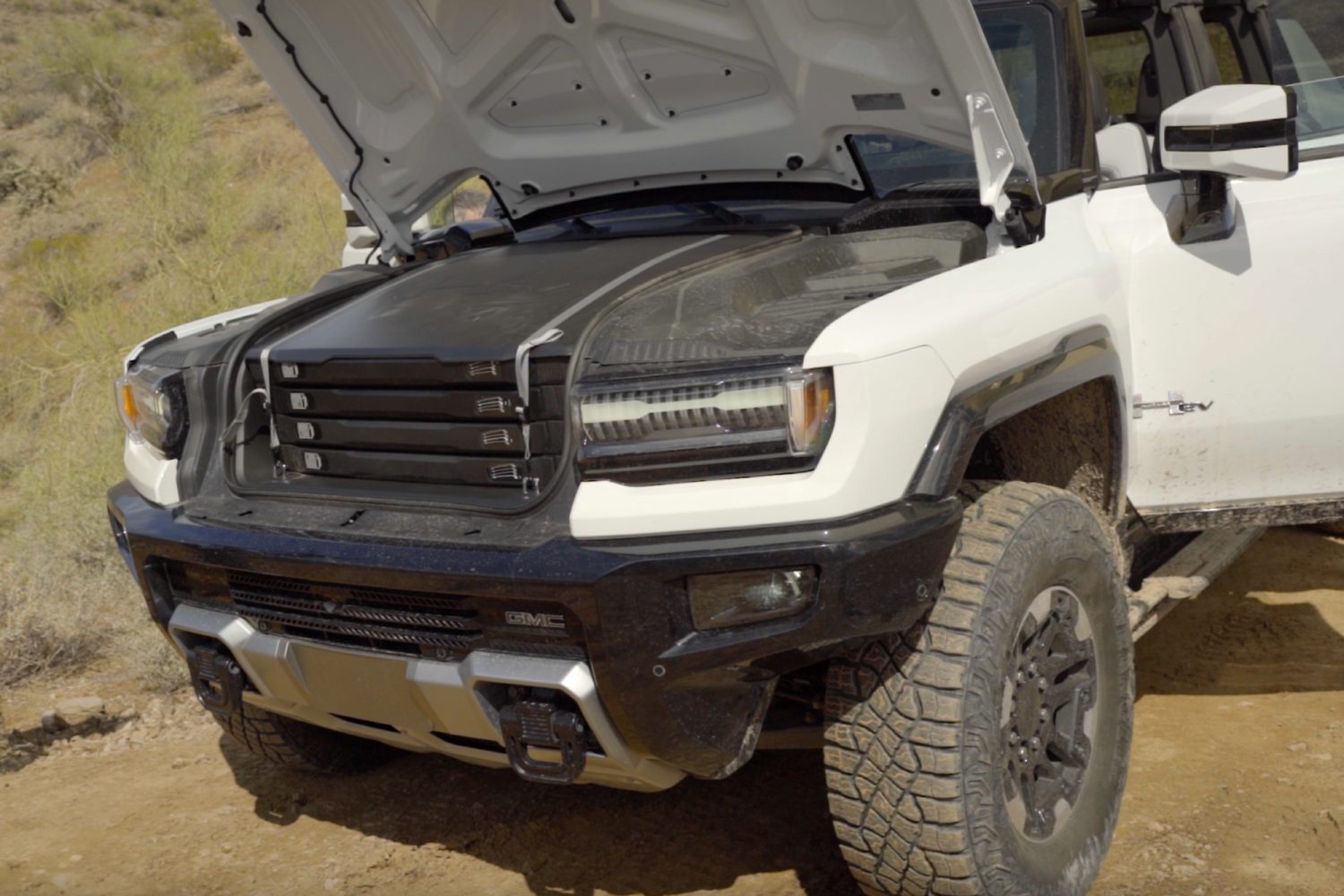
Acceleration, Torque, and 4-Wheel Steering, oh my!
I like to think of the Hummer EV as the Swiss Army knife of vehicles. It’s incredible how many features are packed into it, and even more impressive that these are often qualities that are found at opposite ends of the vehicle spectrum. It’s fast. It’s capable. It’s comfortable. It’s luxurious.
Acceleration
Quick 0-60 times are generally reserved for sporty-looking low-profile sedans and coupes, but supertrucks have proven that you don’t need to be compact to unleash incredible speed. Case in point, the Hummer EV can achieve 60 miles per hour in just 3 seconds with Watts to Freedom.

This fast acceleration has its place on pavement – think on ramps, overtaking other vehicles, and when making evasive maneuvers – but on dirt, fast acceleration tends to be a bit of a party trick. Speed is fun, and I won’t deny that it puts a goofy grin on my face. But it’s rarely (I won’t say never) necessary in off-highway driving situations. It’s important to remember that damaging trails by driving excessively fast can threaten access for all.
Suffice to say, the Hummer is incredibly, mind-numbingly fast.
Torque
More important for off-highway travel than blazing-fast speed is ample torque, and the Hummer delivers. Many outlets (us included) initially quoted 11,500 pound-feet, to much contention. This seemingly-impossible value is torque measured at the wheels, a number that multiplies engine torque by the gearing in the drivetrain. A much more relatable 1,200 pound-feet (what the Hummer EV generates at the motor) feels like a more honest way to compare its power to other vehicles. Scott Brady’s technical evaluation of the Hummer EV will go into more detail on this topic.
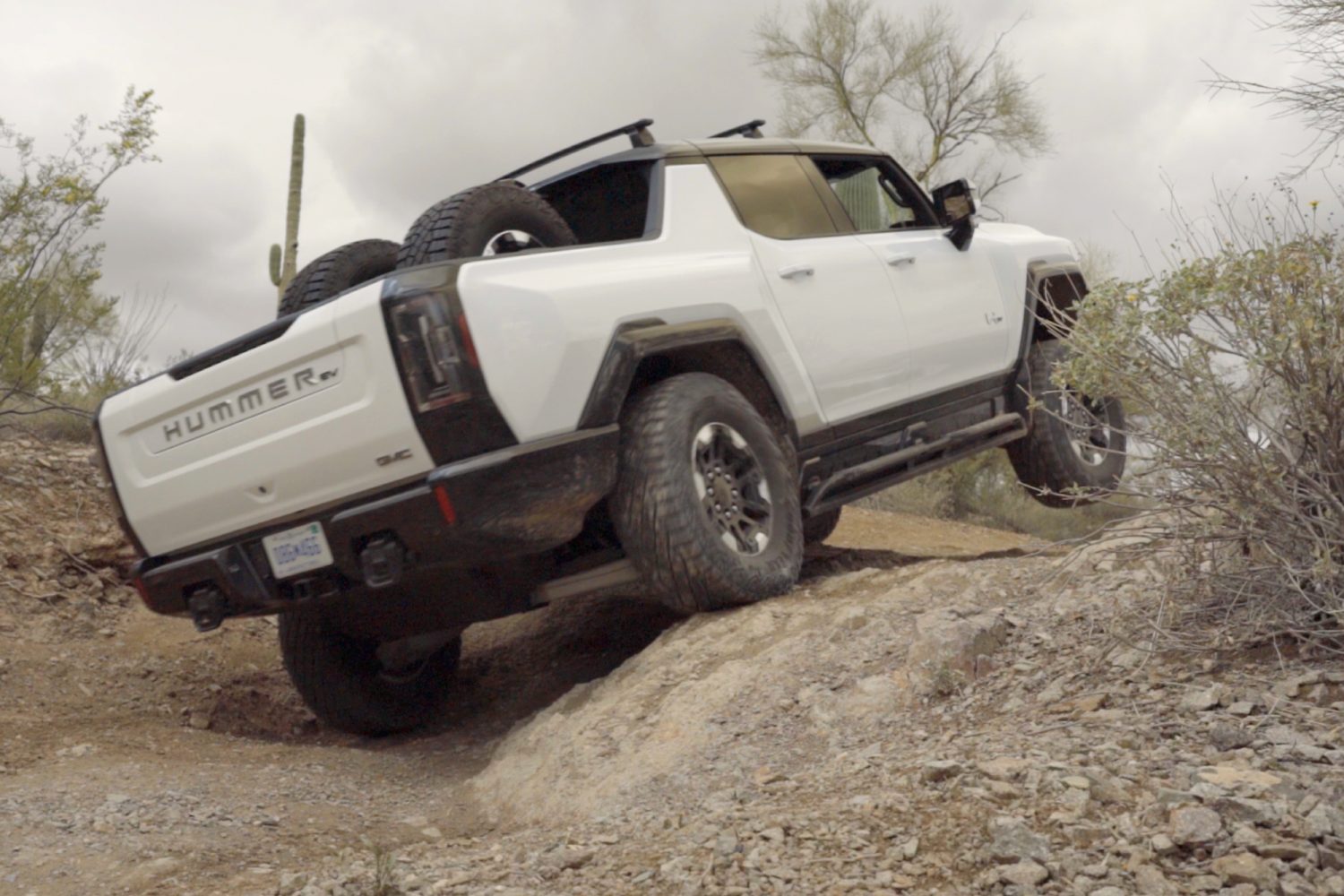
4-Wheel Steering (My Favorite Hummer EV Feature)
If I had to pick my favorite feature found in the Hummer EV’s arsenal of tech, it would be the not-so-futuristic 4-Wheel Steering (more common in the automotive world than you would think). GMC used to call this Quadrasteer, and it was a feature that was available in the early 2000’s on their Sierra pickup.
This feature alone, added to any large off-road vehicle, fundamentally changes the way we experience narrow backcountry roads. I hope you all get to experience it at some point.
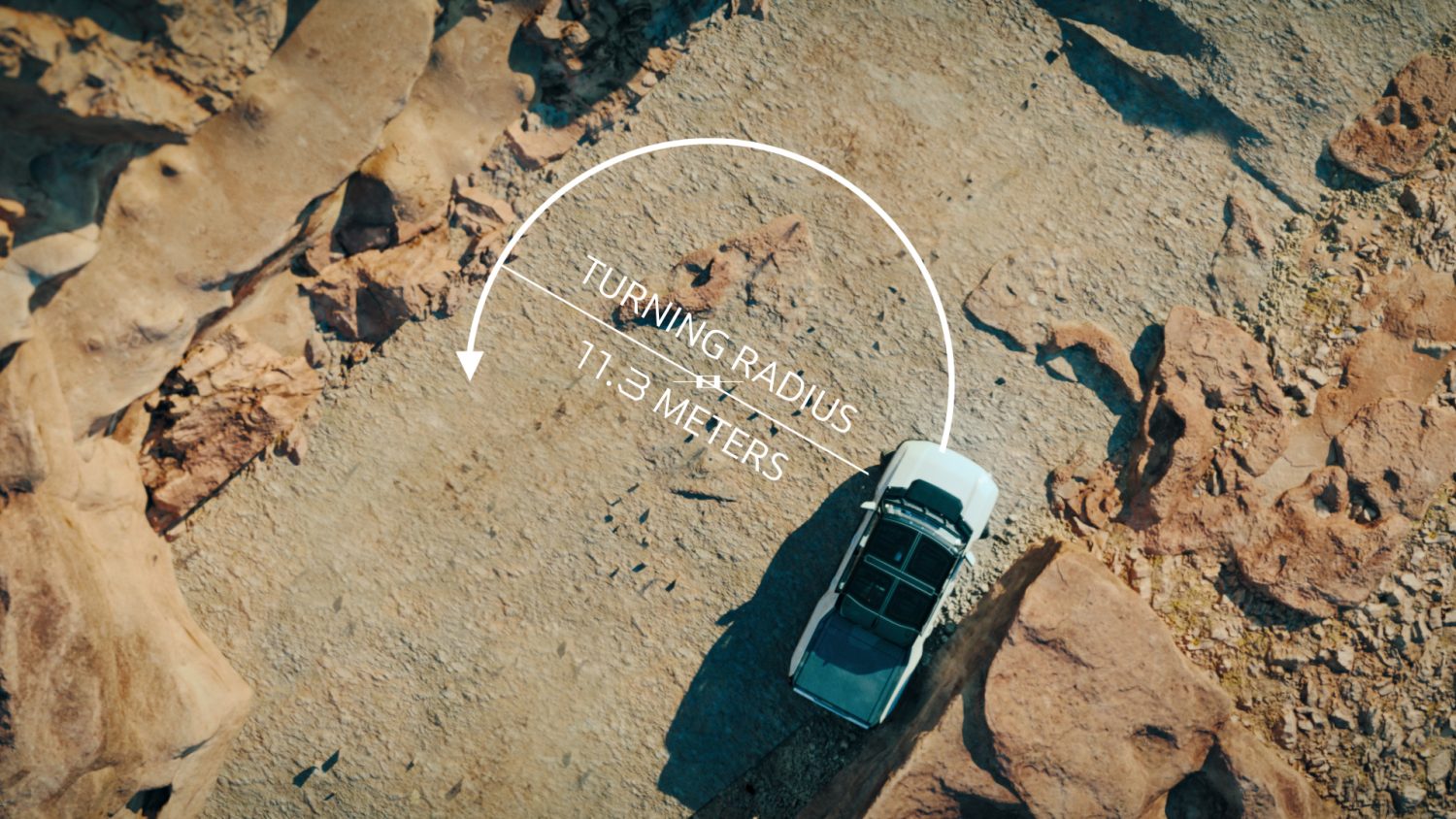
4-Wheel Steer all but erased any anxiety that I experienced while piloting the 10,000-pound Hummer through narrow climbs, dense cactus gardens, and down rocky descents. The vehicle was a ballerina, elegantly dancing its way through every obstacle on the test course.
This feature improves the driving experience both on and off the pavement and adds incredible capability to this truck.
Related to 4-Wheel Steer, the truck’s Crab Walk feature felt completely alien and I’m not yet sure how I feel about its practicality. There are certainly times when it can be put to use, like when Scott piloted the Hummer sideways out of a tightly-spaced line of parked vehicles. Ultimately, I would need more time and opportunity to put this feature to use before asserting whether or not it’s necessary. It looks cool though.
Hummer EV: Additional Considerations
Now that you have a general overview of the design elements and driving features that make the Hummer EV unique, what else is there to consider?
EV Range Anxiety
One of the biggest points that people tend to make when arguing against the practicality of electric vehicles is their limited range and the hassle of needing to stop to re-charge. But with approximately 329 miles of range, the Hummer EV delivered a full day of driving without the need to recharge. This included approximately two and a half hours of highway driving, and two hours of driving on an off-highway course, including multiple steep obstacles. By the time we returned to our starting point, the battery power remaining as indicated by the vehicle was approximately 45%.

In general, I believe that most people will find this performance acceptable. But let’s be real; if you are planning a long-distance road trip in this truck, you will have to stop to charge the batteries. But is this really so much less convenient than stopping to fuel up an IC vehicle?

While we didn’t need to charge during our test drive, it’s worth mentioning that plugging the Hummer EV into a level two, eight-hundred-volt DC charger will recover one-hundred miles of range in just ten minutes of charging. Compelling.
Will the Hummer EV go Overland? Payload, Additional Equipment, Vehicle Modifications, Capability, Silence, and Price
This is Expedition Portal, and we do concern ourselves with overland travel. So what do we think about the Hummer EV as an overland rig?

Payload
Let’s start with the Hummer’s payload, which is approximately 1,300 pounds. While it may seem anemic given the power and size of this rig, it’s certainly enough for a full complement of camping equipment. However, if you plan to haul around four large passengers, including all of their personal equipment, and food, you could approach the truck’s limit.
Additional Equipment
GMC will offer a variety of optional equipment for off-highway travel including lighting (ditch lights, roof-mounted light bar), a bed rack, which at the test drive had a Freespirit Roof tent mounted, and a dual spare tire mount that bolts into the bed of the truck.

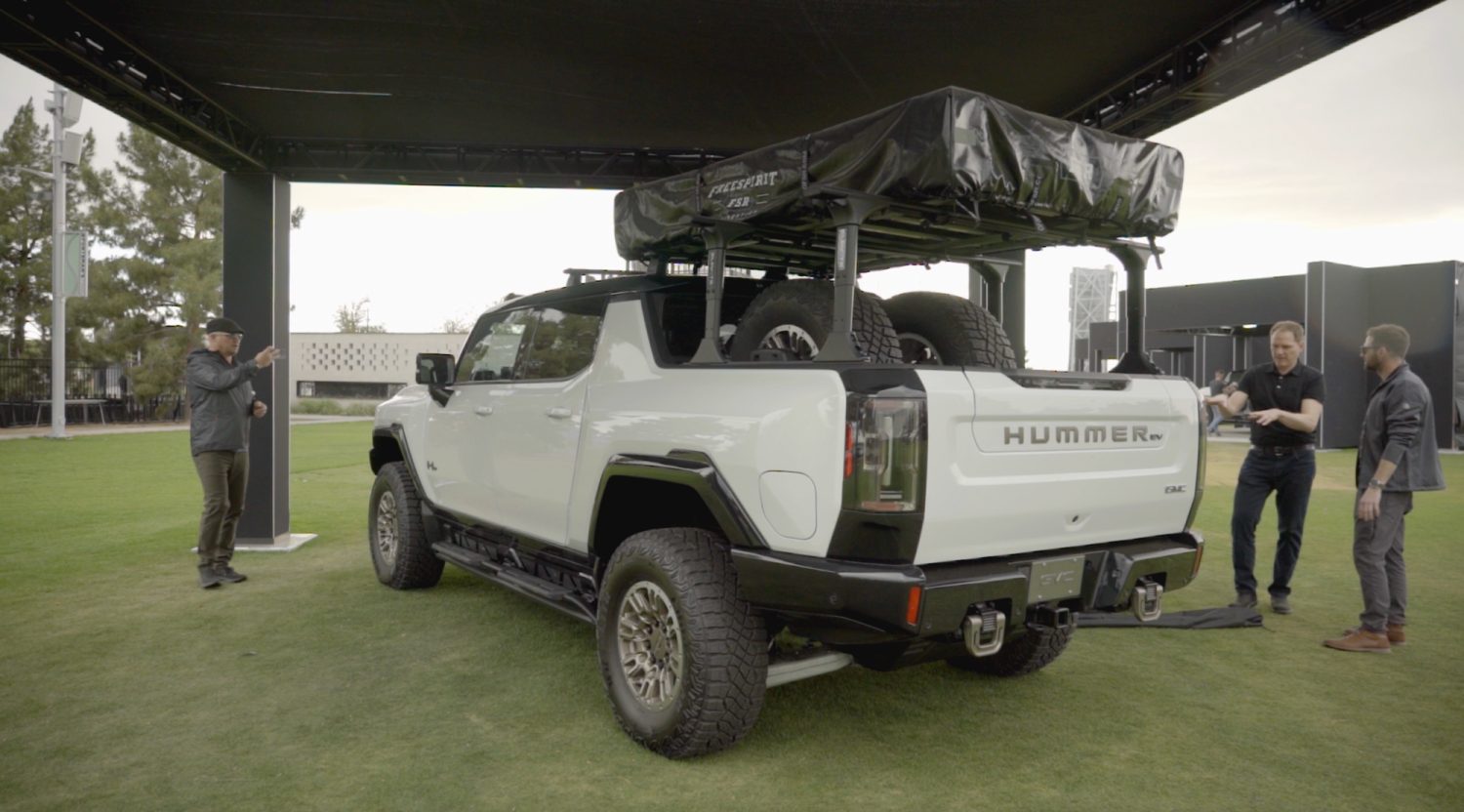
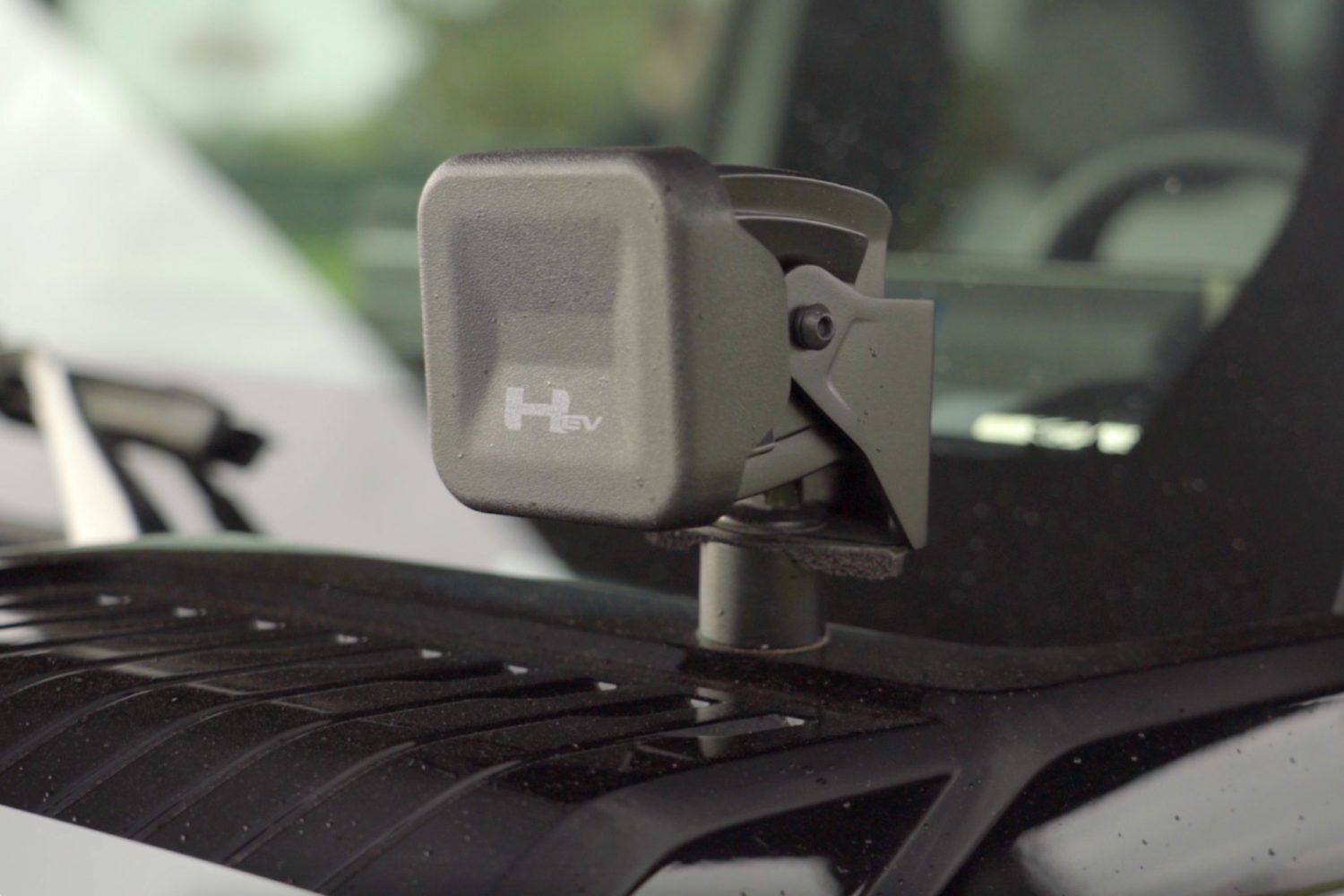
Vehicle Modifications
Many of us love the prospect of modifying our vehicles with aftermarket lifts, wheels, bumpers, and more, but the beauty of the Hummer EV is that little if any of these things are necessary to go tackle a challenging trail. From its futuristic, flat undercarriage (almost nothing to get hung up or damaged) which is fully protected with boron-steel skid plating, to its air-sprung active suspension, locking differentials, and 35-inch tires (on 18’s), this truck is an absolute beast.
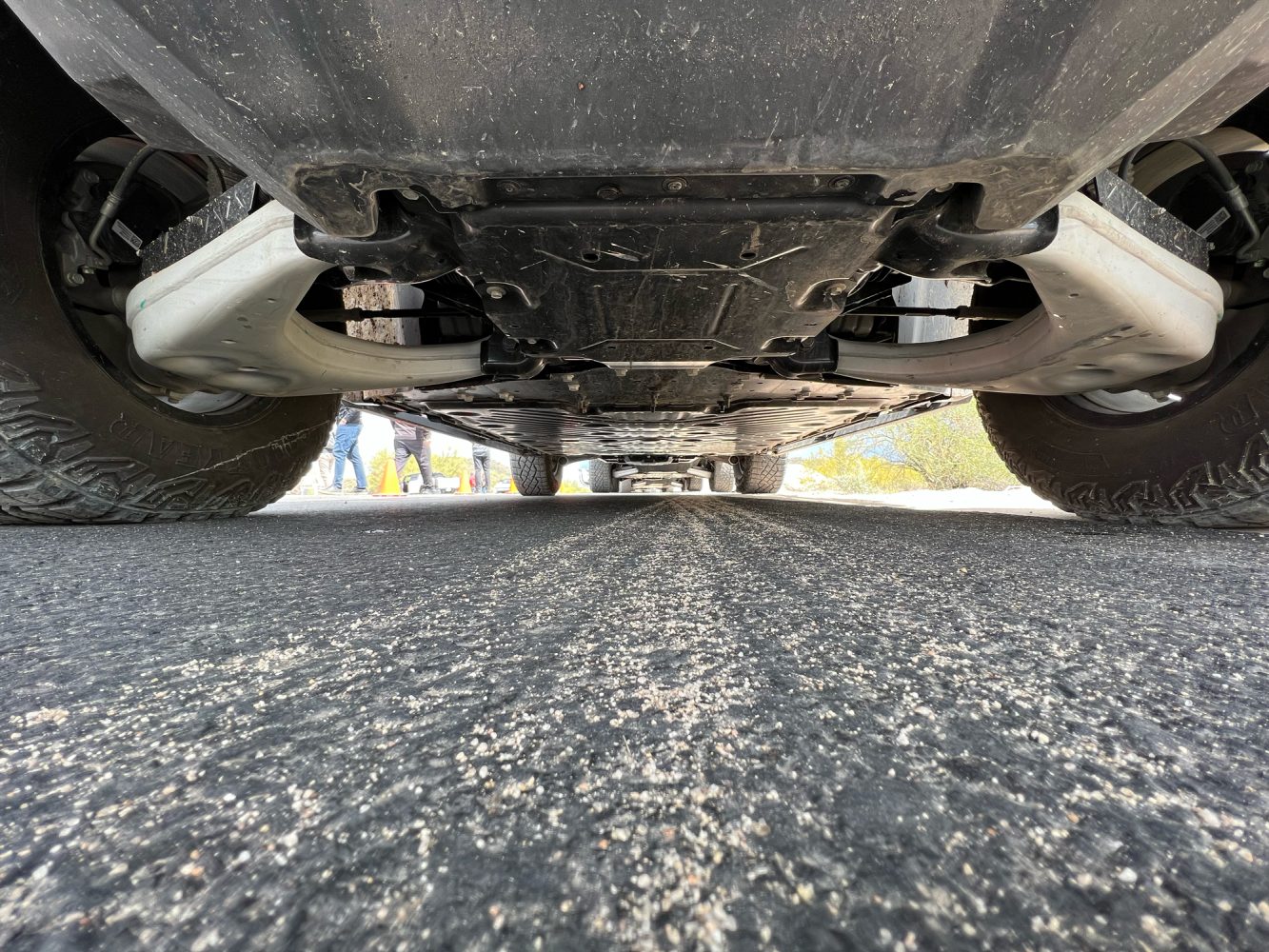
Capability
I’ve mentioned this truck’s incredible capabilities already, but in regard to overland travel, which includes performance on the pavement as well as dirt, this truck bests just about any “overland rig” I’ve had the pleasure of piloting.

Its low-slung mass delivers a precise driving experience that is completely at odds with its size. It’s fast, nimble, torquey, and has loads of features to reduce driver fatigue. The adaptive air shocks really deliver. It provides the utility of a small truck bed for hauling around gear, and can even do some light towing.
To be fair, I didn’t get to drive the Hummer EV at its payload limit, a real-world experience that is completely relevant to us as overland travelers and one that I hope we can perform at a later date. Stay tuned.
Silence
The quality of driving a nearly silent vehicle on the trail is profound. I first experienced this when I test drove the Jeep Wrangler 4xe, and the Hummer EV further reinforced my belief that a quiet experience on the trail is better for all. With the windows down, there is no engine noise to compete with when talking to those inside or outside the vehicle. And this newfound silence even provides new opportunities, like sneaking up on rarely-seen wildlife in the backcountry; we enjoyed this very experience on our trail ride when Javalina crossed our path.
Price
As a final consideration: the Edition One Hummer EV retails for $108,700. For less than half this price you could easily find a vehicle with twice the payload and double the towing capacity. In that same vein of thought, you could purchase just about any four-wheel drive you desire (within reason), and ship it anywhere in the world.
Is there a case for a lower lifetime cost of ownership versus an IC vehicle? Perhaps, and I’d love to see a well-researched investigation of this.
I guess my takeaway thought on price is this: if you want an incredibly capable vehicle and $108,700 is within your budget, I’m fairly certain that the Hummer EV will impress you.
Conclusion
My time behind the wheel of the Hummer EV further stoked my excitement for the future of electric vehicles. And the fact that this truck was brought to market in roughly half the timeline of traditional vehicle development programs blows my mind.
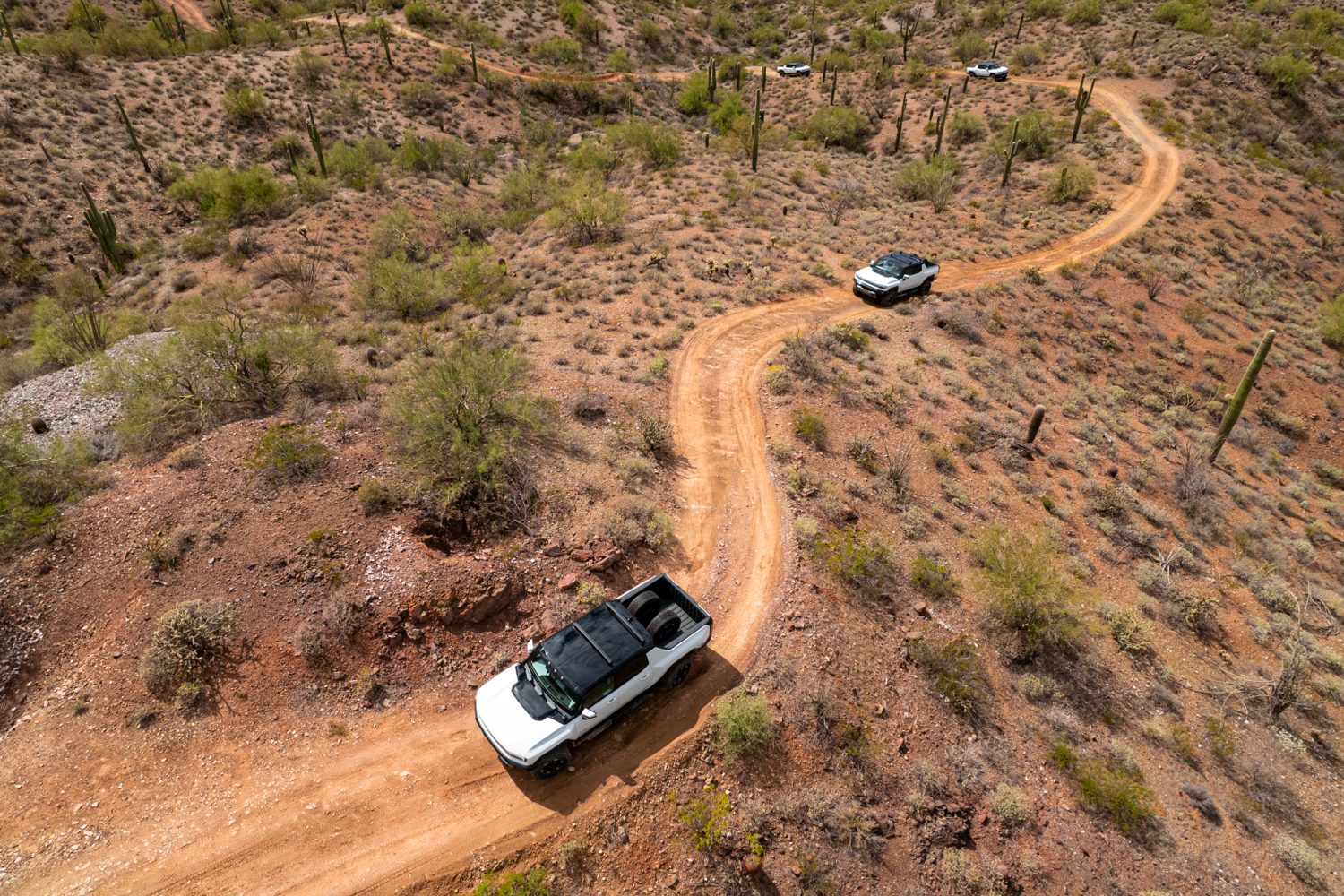
Capability, performance, and interior design all felt completely indulgent and come with a six-figure price tag, putting it out of reach for most of us regular folks. Nonetheless, this is an exciting moment in the development of electric vehicles and further proof that electric drivetrains will continue to redefine our expectations of vehicle performance, both on and off-road.
Our No Compromise Clause: We carefully screen all contributors to ensure they are independent and impartial. We never have and never will accept advertorial, and we do not allow advertising to influence our product or destination reviews.



